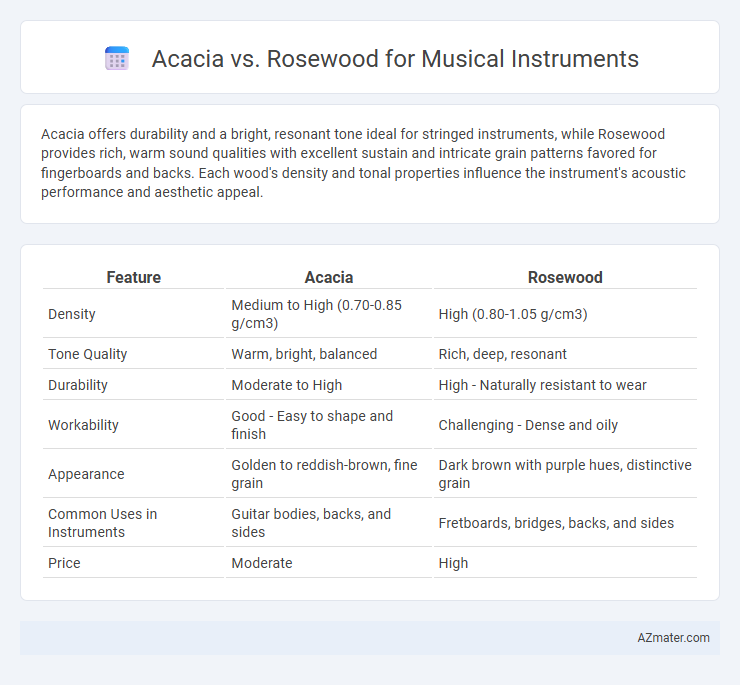Acacia offers durability and a bright, resonant tone ideal for stringed instruments, while Rosewood provides rich, warm sound qualities with excellent sustain and intricate grain patterns favored for fingerboards and backs. Each wood's density and tonal properties influence the instrument's acoustic performance and aesthetic appeal.
Table of Comparison
| Feature | Acacia | Rosewood |
|---|---|---|
| Density | Medium to High (0.70-0.85 g/cm3) | High (0.80-1.05 g/cm3) |
| Tone Quality | Warm, bright, balanced | Rich, deep, resonant |
| Durability | Moderate to High | High - Naturally resistant to wear |
| Workability | Good - Easy to shape and finish | Challenging - Dense and oily |
| Appearance | Golden to reddish-brown, fine grain | Dark brown with purple hues, distinctive grain |
| Common Uses in Instruments | Guitar bodies, backs, and sides | Fretboards, bridges, backs, and sides |
| Price | Moderate | High |
Introduction to Acacia and Rosewood in Instrument Making
Acacia and Rosewood are both prized tonewoods in musical instrument making, known for their unique acoustic properties and aesthetic appeal. Acacia offers a bright, clear sound with excellent sustain, making it popular for acoustic guitar backs and sides, while Rosewood provides rich, complex overtones and deep bass response favored in high-end guitars and string instruments. The choice between Acacia and Rosewood influences the instrument's tonal character, playability, and durability, reflecting distinct regional varieties and sustainable sourcing practices.
Botanical Origins and Species Overview
Acacia wood, derived from the Acacia genus primarily found in Australia and Africa, is known for its dense grain and durability, making it ideal for guitar backs and sides. Rosewood, sourced from the Dalbergia genus native to tropical regions of South America and Asia, offers a rich tonal quality with its complex, dark veining used extensively in fretboards and soundboards. Both species are hardwoods prized for their acoustic properties, with Acacia providing a bright, articulate sound and Rosewood delivering warm, resonant tones favored in high-end instruments.
Physical Properties: Density and Hardness Comparison
Acacia wood has a density ranging from 700 to 900 kg/m3, offering a moderate hardness on the Janka scale typically between 1700 to 2200 lbf, making it durable and resistant to wear for musical instruments. Rosewood, particularly Indian and Brazilian varieties, is denser and harder, with densities often between 800 to 1050 kg/m3 and Janka hardness values from 2200 to 2800 lbf, providing superior strength and a rich tonal quality. The higher density and hardness of Rosewood contribute to greater sustain and resonance, while Acacia's balanced properties make it a lighter alternative with good acoustic performance.
Acoustic Qualities of Acacia vs Rosewood
Acacia wood offers a warm, bright tonal quality with excellent clarity and a balanced midrange, ideal for producing crisp acoustic notes in musical instruments. Rosewood is renowned for its rich, resonant bass, complex overtones, and strong projection, making it a preferred choice for premium guitars and stringed instruments. The dense grain structure of Rosewood enhances sustain and tonal depth, while Acacia's lightweight nature contributes to a more articulate and vibrant sound profile.
Visual Aesthetics: Grain Patterns and Coloration
Acacia offers musical instruments with striking, varied grain patterns featuring rich golden to deep amber hues that enhance natural warmth and elegance. Rosewood is prized for its dense, swirling grains and deep reddish-brown to purplish-black coloration, providing a luxurious and dramatic visual appeal. Both woods contribute unique aesthetic qualities, with Acacia emphasizing brightness and complexity, while Rosewood highlights depth and richness in tone and appearance.
Workability and Crafting Challenges
Acacia wood offers excellent workability due to its medium density and consistent grain, making it easier to shape and finish for musical instruments like guitars and violins. Rosewood, while prized for its rich tonal qualities, presents crafting challenges because of its higher density and natural oils, which require specialized tools and finishes to avoid clogging and uneven textures. Both woods demand skill, but Acacia's smoother machining process often results in faster production times with less risk of cracking or splintering.
Tonal Characteristics in Guitars and String Instruments
Acacia wood produces warm, bright tones with clear midrange and balanced highs, making it ideal for acoustic guitars and string instruments seeking versatility and resonance. Rosewood offers rich, complex overtones and deep bass response, favored for its sustained sound and strong projection in high-end guitars and fretboards. The tonal differences reflect Acacia's clarity and Rosewood's warmth, influencing musicians' choices based on preferred sound texture and playability.
Durability and Long-Term Performance
Acacia wood offers exceptional durability and resistance to moisture, making it a reliable choice for musical instruments that endure frequent handling and varying environmental conditions. Rosewood, prized for its dense structure, provides superior tonal richness and long-term stability, often enhancing sound quality over extended use. Instruments crafted from rosewood tend to maintain structural integrity and resonance longer, though acacia's resilience makes it a strong alternative for durability-focused performance.
Sustainability and Environmental Impact
Acacia wood offers a sustainable choice for musical instruments due to its fast growth cycle and wide availability, reducing deforestation risks compared to rosewood, which is often harvested from endangered species. Rosewood's exploitation has led to stricter regulations, including CITES restrictions, severely impacting its environmental footprint and availability. Using acacia supports eco-friendly instrument production while maintaining quality tone and durability, aligning with environmentally conscious practices in the music industry.
Price and Market Availability
Acacia wood is generally more affordable and widely available in the musical instrument market compared to rosewood, which is often priced higher due to its rarity and restricted trade regulations under CITES. Rosewood's scarcity and conservation status drive up its cost, making it a premium choice for high-end guitars and string instruments, while acacia serves as a cost-effective alternative with good tonal qualities. Market availability for rosewood is limited and fluctuates based on export bans, whereas acacia is more consistently accessible, supporting stable pricing and supply for instrument manufacturers.

Infographic: Acacia vs Rosewood for Musical Instrument
 azmater.com
azmater.com